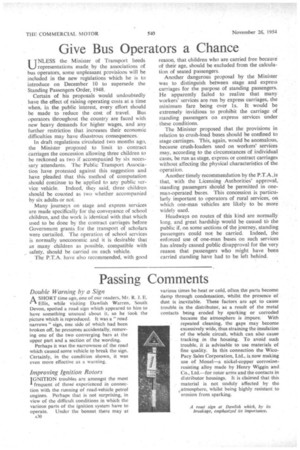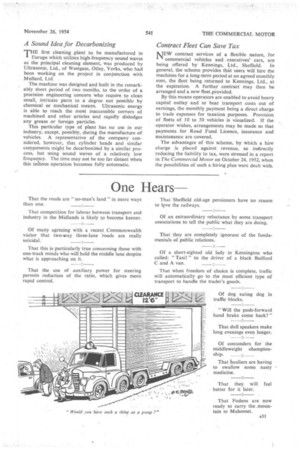Passing Comments
Page 32

Page 33

If you've noticed an error in this article please click here to report it so we can fix it.
Double Warning by a Sign
ASHORT time ago, one of our readers, Mr. R. J. E. Ellis, while visiting Dawlish Warren, South Devon, spotted a road sign which appeared to him to have something unusual about it, so he took the picture which is reproduced. It was a "road narrows" sign, one side of which had been broken off, he presumes accidentally, removing one of the two converging bars at the upper part and a section of the wording.
Perhaps it was the narrowness of the road which caused some vehicle to break the sign. Certainly, in the condition shown, it was even more effective as a warning.
Improving Ignition Rotors
IGNITION troubles are amongst the most I frequent of those experienced in connection with the running of road-vehicle petrol engines. Perhaps that is not surprising, in view of the difficult conditions in which the various parts of the ignition system have to operate. Under the bonnet there may at A30 various times be heat or cold, often the parts become damp through condensation, whilst the presence of dust is inevitable. These factors are apt to cause trouble in the distributor, as a result of the metal contacts being eroded by sparking or corroded because the atmosphere is impure. With repeated cleaning, the gaps may become excessively wide, thus straining the insulation of the whole circuit, which can also cause tracking in the housing. To avoid such trouble, it is advisable to use materials of fine quality. In this connection the WicoPacy Sales Corporation, Ltd., is now making use of Monel—a nickel-copper corrosionresisting alloy made by Henry Wiggin and Co., Ltd.—for rotor arms and the contacts in distributor housings. It is claimed that this material is not unduly affected by the atmosphere, whilst being highly resistant to erosion from sparking.
A Sound Idea for Decarbonizing
fHE first cleaning plant to be manufactured in Europe which utilizes high-frequency sound waves as the principal cleaning element, was produced by Ultrasonic, Ltd., of Westgate, Otley, Yorks, who had been working on the project in conjunction with Mullard, Ltd.
The machine was designed and built in the remarkably short period of two months, to the order of a precision engineering concern who require to clean small, intricate parts to a degree not possible by chemical or mechanical means. Ultrasonic energy is able to .reach the most inaccessible corners of machined and other articles and rapidly dislodges any grease or foreign particles.
This particular type of plant has no use in our industry, except, possibly, during the manufacture of vehicles. A representative of the company considered, however, that cylinder heads and similar components might be decarbonized by a similar process, but using sound waves of a relatively low frequency. The time may not be too far distant when this tedious operation becomes fully automatic.
Contract Fleet Can Save Tax KiEw contract services of a flexible nature, . for commercial vehicles and executives' cars, are
being offered by Kennings, Ltd., Sheffield. In general, the scheme provides that users will hire the machines for a long-term period at an agreed monthly sum, the fleet being returned to Kennings, Ltd., at the expiration. A further contract may then be arranged and a new fleet.provided.
By this moans operators are enabled to avoid heavy capital outlay and to• bear transport costs out of earnings, the monthly payment being a direct charge to trade expenses for taxation purposes. Provision of fleets of 10 to 50 vehicles is visualized. If the operator wishes, arrangements may be made so that payments for Road Fund Licence, insurance and maintenance are covered.
The advantages of this scheme, by which a hire charge is placed against revenue, so inAirectly reducing the liability to tax, were stressed in a report in The Commercial Motor on October 24, 1952, when the possibilities of such a hiring plan were dealt with.




























































































